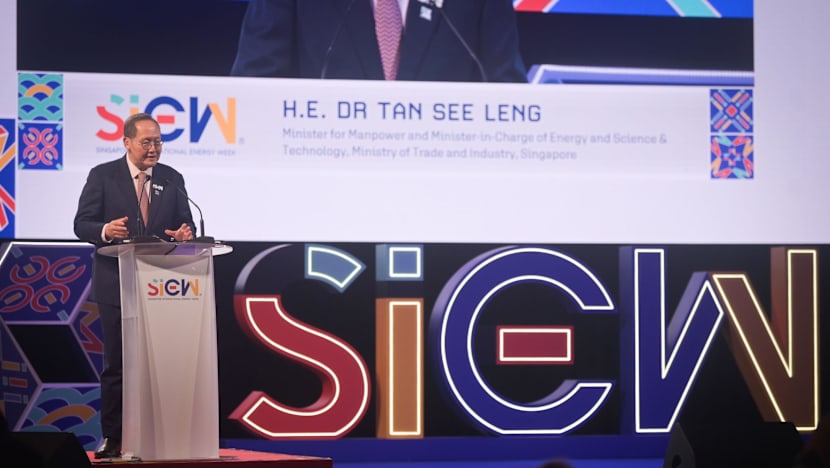Singapore to deepen nuclear energy cooperation with US institutes, issues background paper to allay public concerns
Apart from nuclear, Singapore has other low-carbon pathways towards decarbonisation, and is also exploring biomethane as a viable option.

Minister-in-charge of Energy and Science & Technology Tan See Leng speaking at the Singapore International Energy Week 2025 on Oct 27, 2025. (Photo: CNA/Syamil Sapari)

This audio is generated by an AI tool.
SINGAPORE: Singapore on Monday (Oct 27) released a background paper on building its capabilities to assess nuclear energy, providing an overview of its interests in potentially using the energy source to power the country's needs and to help inform the public on its benefits and risks.
Minister-in-charge of Energy and Science & Technology Tan See Leng announced the paper at the opening of the annual Singapore International Energy Week (SIEW) while noting that the public had "many questions" about the country's plans for nuclear energy.
"We are also seriously studying the potential deployment of nuclear energy, especially newer technologies such as small modular reactors.
"Nuclear energy has the potential to be a safe, reliable, and cost-competitive option for Singapore," Dr Tan said while delivering the Singapore Energy Lecture at the Marina Bay Sands' Expo and Convention Centre.
SIEW, into its 18th edition and slated to run until Friday, is a platform for professionals and policymakers to share best practices and solutions within the global energy space. It is organised by Singapore's Energy Market Authority (EMA), a statutory board under the Ministry of Trade and Industry (MTI).
CONSIDERATIONS FOR NUCLEAR ENERGY
While Singapore has not decided whether to deploy nuclear energy, it is making efforts to study its potential.
In 2012, the government conducted a pre-feasibility study which concluded that nuclear power plants at that time were not suited for Singapore's small and densely populated circumstances.
Its latest 16-page background paper outlined Singapore's considerations for nuclear energy in the context of the latest developments in technology, the current global landscape and nuclear safety. The paper is a joint effort between MTI, EMA the Ministry of Sustainability and the Environment, and the National Environment Agency.
Nuclear energy is an option as it has the potential to help Singapore address the energy trilemma, the paper stated.
The energy trilemma refers to Singapore's three objectives for its energy mix, namely for energy to be clean, affordable and secure.
The paper stated that Singapore is building its capabilities in line with the International Atomic Energy Agency's "Milestones Approach", a process that helps countries understand the requirements for deploying nuclear energy.
"This ensures that any future decision is taken in line with global standards on nuclear safety, security and safeguards", stated the background paper.
Generating nuclear energy does not produce greenhouse gases, making it a source of clean electricity. Its cost could potentially be comparable to other energy pathways such as natural gas and solar.
As a domestic source of energy, nuclear could be resilient to shocks in the global market.
Globally, nuclear power plants have been in operation since the 1950s and supply 10 per cent of the world’s electricity needs today. Currently, there are more than 400 operational nuclear power plants, with several new projects ongoing across Asia, Europe, America and Africa.
Advances in nuclear technology in the past decade, particularly in the area of small modular reactors (SMRs), have made atomic energy a more feasible option. SMRs are a fraction of the size of a conventional nuclear reactor, can be prefabricated for easier transport and installation, and are safer.
Many such models of reactors have been moving from concept to implementation in recent years, the background paper observed.
For Singapore, any decision to deploy nuclear energy will consider its safety, reliability, affordability, and environmental sustainability within the country's context, the paper stated.
"We will continue our efforts to build up domestic capabilities, supported by international partners," it noted. "We will engage the public regularly on the latest developments in nuclear energy, to build an informed understanding of the benefits and risks surrounding nuclear energy."
AGREEMENTS WITH US ORGANISATIONS ON NUCLEAR
To strengthen Singapore's expertise in the subject, the EMA will be signing new cooperation agreements with two United States organisations, the Idaho National Laboratory and Battelle Memorial Institute at SIEW, Dr Tan announced during his speech.
Idaho National Laboratory, the US’ nuclear energy laboratory for advanced nuclear energy, runs initiatives that help the global nuclear community commercialise innovations such as advanced fuels and reactors.
EMA will sign a letter of intent with the lab to work towards establishing a formal Cooperative Research and Development Agreement to collaborate on studies, technical assessment and capability building in advanced nuclear energy technologies, said the authority in a statement.
Battelle Memorial Institute is an independent, non-profit applied science and technology organisation that applies advanced science, technology and engineering towards complex challenges, including in the field of nuclear energy. It has supported the US government and private sector in developing and evaluating nuclear energy technologies for more than 60 years.
The memorandum of understanding that EMA and Battelle Memorial Institute will sign provides a framework for cooperation between both parties to study aspects of nuclear energy and advanced reactor technologies, EMA said.
These cooperation agreements come on the back of other agreements signed between Singapore and the US in recent years.
In July last year, Singapore and the US inked a civil nuclear cooperation agreement known as the "123 Agreement", which would facilitate Singapore's access to information and technological expertise. In January this year, both countries signed a Memorandum of Understanding Concerning Strategic Civil Nuclear Cooperation.
SINGAPORE'S ENERGY TRANSITION AMID GLOBAL UNCERTAINTY
In his speech, Dr Tan, who is also the Minister for Manpower, noted the challenges that Singapore faced in its energy transition amid a backdrop of geopolitical uncertainty.
"Rising geopolitical uncertainties have led to countries reassessing their climate ambitions, placing renewed emphasis on economic resilience and self-sufficiency, at the expense of decarbonisation efforts," Dr Tan said. "Yet, we all know nature will wait for no man. Climate change continues to accelerate, and its impact will profoundly affect how we work, how we live, and how we thrive."
Singapore will continue to work towards decarbonisation goals with "urgency and with resolve", he added while touching on the country's various pathways to achieve its targets.
One of these is solar power, which remains the most "viable renewable energy option" in alternative-energy disadvantaged Singapore. Dr Tan noted that Singapore is on track to meeting its solar power deployment target of at least two gigawatt-peak (GWp) earlier than 2030.
Meanwhile, the government will continue to encourage businesses and homeowners to install solar panels within their premises by streamlining regulatory processes, and will continue to explore the potential of innovative urban applications too.
Though necessary, solar energy by itself will be insufficient for Singapore's needs, as it will likely supply a maximum of 10 per cent of the country's total projected electricity demand in 2050 due to land constraints.
Singapore's future energy mix depended on "technological and commercial trajectories for different pathways" but will fundamentally be a "a blend of indigenous sources with imported green electrons and molecules", Dr Tan said.
"We must stand ready to support all promising sustainable pathways – from established technologies to frontier options."
BIOMETHANE A PROMISING PATHWAY TO DECARBONISATION
Singapore is also exploring biomethane as a viable low-carbon fuel option and will be establishing a regulatory sandbox of up to 300 megawatts to spur supply chain development and facilitate adoption by key industry players, Dr Tan announced.
He added that selected power generation companies will be appointed as supply and demand aggregators as early as next year.
Biomethane is a renewable fuel that can replace fossil natural gas. It is produced by upgrading biogas from organic waste or residues to almost pure methane. Methane is the main component of natural gas, which accounts for 95 per cent of Singapore's energy mix for power generation.
Due to its compatibility with Singapore's existing natural gas infrastructure, biomethane can be "dropped" in without costly retrofits.
"The biomethane sandbox aims to catalyse market development by facilitating matchmaking between supply and demand in Singapore's energy ecosystem, while providing a controlled environment to test commercial viability and operational frameworks prior to broader market deployment beyond the 300 megawatts capacity of the sandbox," EMA said in a media factsheet about piloting biomethane imports.
Singapore's only liquefied natural gas (LNG) facility is prepared to handle cleaner forms of energy in the future, amid the country's push for renewables. That's even as latest data in July showed over 90% of electricity is generated using natural gas, which is a fossil fuel. Eugene Chow goes behind the scenes to find out how the facility currently works.
MAKING NATURAL GAS GENERATION SYSTEMS MORE EFFICIENT
Even while exploring alternatives fuel sources to decarbonise, natural gas will still play a fundamental role in ensuring system reliability, Dr Tan said.
"Given this, we must maximise the efficiency of these generation systems while enhancing the resilience of our gas supplies," he added.
The government has rolled out an incentive scheme for efficiency to encourage the adoption of advanced natural gas power plants that are more carbon-efficient, Dr Tan said.
To this end, the EMA will be awarding up to S$44 million (US$33.9 million) under the Advanced Combined Cycle Gas Turbine (CCGTs) Incentive Scheme to operators of the first two advanced CCGTs - Keppel’s Infrastructure Division and Sembcorp Industries. They are expected to be deployed by the end of next year.
Advanced CCGTs are more efficient power plants with larger capacities for electricity generation than current CCGTs in the power system.
The advanced CCGTs operated by Keppel and Sembcorp are expected to produce at least 200,000 tonnes less carbon emissions annually than current CCGTs in the power system currently. This is equivalent to reducing the carbon emissions of around 80,000 households in Singapore in a year.
Advanced CCGTs incur additional reserve costs given their larger capacities, as they need larger reserves for contingencies, EMA said in a factsheet. The scheme will help to offset the additional reserve cost for Keppel and Sembcorp as the first two adopters of advanced CCGTs in Singapore.
"As more advanced CCGTs are deployed, the reserve cost is shared across more CCGTs and the cost borne per CCGT will decrease. At that point, advanced CCGTs are not expected to incur any more cost disadvantage compared to current CCGTs as efficiency benefits outweigh the cost," EMA said.
Related:
DECARBONISING INDUSTRIES
Singapore will also transform industrial sectors to help them decarbonise, said Dr Tan.
He announced a "refreshed" direction for Jurong Island, Singapore's energy and chemicals (E&C) hub, to power the future of low-carbon innovation in the E&C sector.
The 3,000ha island was initially conceptualised as a chemical hub when officially opened in 2000 in southwestern Singapore.
Now, home to more than 100 global E&C companies, Jurong Island is on track to meet its 2030 Sustainable Jurong Island goals from its 2021 report. The report outlined plans to transform Jurong Island into a sustainable E&C park that operates sustainably and exports sustainable products globally.
As part of the plans, the government had also detailed key goals for the E&C sector by 2030, one of which is to increase the output of sustainable products by 1.5 times from 2019 levels.
Giving an update on this goal, Dr Tan said the sector's output of sustainable products has increased by 1.4 times since 2019, placing it on track for its eventual goal.
Jurong Island will also be a testbed for new energies and low-carbon technologies.
Earlier this year, the government announced that the Agency for Science, Technology and Research (A*STAR) will be opening a S$62.5 million testbed facility on Jurong Island, so that companies can test their technologies before scaling up for commercial development.
Companies and startups have since expressed interest in using this cost-effective, modular testbed to scale up emerging technologies for commercial development, Dr Tan said.
Jurong Island will also host Singapore’s largest low-carbon data centre park to accommodate up to 700 megawatts of capacity.
Other clean energy projects include Sembcorp's energy storage system and Singapore's largest ground-mounted solar project, a solar farm that generates enough to power around 33,200 four-room HDB flats annually.


















